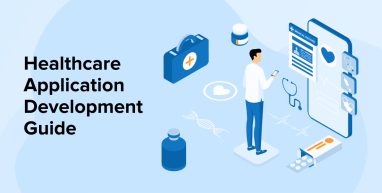
Developing digital solutions for the medical industry demands a thorough examination of concepts, market dynamics, and development stages to sustain in the vast healthcare industry.
In this article, you’ll find a complete step-by-step Healthcare software development process. We’ll discuss what a healthcare application is, explain its intricacies, and offer some advice on developing a minimum viable product for a digital healthcare app.
According to Statista In 2019, the global digital health market was worth an estimated 175 billion U.S. dollars. With an expected CAGR of almost 25 percent from 2019 to 2025, the digital health market should reach nearly 660 billion dollars by 2025.
Therefore, make yourself at ease and enjoy the reading!
1. What is Healthcare Application Development?
Healthcare app development is the process in which developers create an application to improve health and wellness, that can help users to better manage their disease with the help of healthcare providers. This app connects patients with healthcare providers and helps them carry out various tasks like appointment booking, online healthcare consultancy, medical reports, billing, and more.
Mobile apps can be designed for both healthcare professionals and patients. Patient monitoring, telemedicine, medical categorization, and billing software assist healthcare professionals in running their operations more effectively.
Mobile medical applications need to be more than just functional; they must also be user-friendly. This is because the application’s intended users come from a diverse range of backgrounds, and not everyone has the technical ability to navigate the mobile application’s features. A well-designed interface is a crucial necessity that has a substantial influence on an app’s performance.
Healthcare application development is a multibillion-dollar worldwide market that is developing at a steady clip. There are more than 350,000 healthcare apps available in different app stores.
Interesting facts on #digital health
— Ruby Gadelrab (@DivaBiotech) June 9, 2022
– 350,000 Health apps in the market today
– 90,000 Were added in 2020
– 250 new apps are released every single day.
BUT
There are only 2000 publications since 2007 demonstrating clinical effectiveness.
Huge Gap In Evidence
Source: IQIVIA
1.1 Types of Healthcare Mobile App Development
With the advancement of technology, the goal of healthcare mobile app development varies. mHealth apps ease our lives by tracking our health data, providing remote support, providing 24/7 access to healthcare providers, and sharing health suggestions. In general, the goal is determined by the mobile app genre you select.
It’s critical to keep the categories in mind when searching for healthcare app developers since you’ll be providing them with input data. Take into account the following classifications of mobile healthcare apps.
1. Mobile Apps For Medical Professionals
The name is self-explanatory. Doctors are involved in professional healthcare app development. These apps serve as mediators between healthcare providers and patients during communication and treatment procedures. Professional mHealth apps such as DrChrono, Medscape, and Locus Clinician are excellent examples. The following is a list of further professional application types:
- Medical app for scheduling doctor appointments.
- Medical apps for electronic medical/health records.
- Mhealth Apps for medical reference.
- Database medical application.
- Health app for tracking your health.
- Mhealth apps for networking (for care providers).
- Telemedicine apps.
2. Mobile Healthcare Apps For Patients
While this sort of mobile healthcare app does not often require the intervention of medical professionals, they do give a wealth of important information for patient data. Consider the following examples: BetterMe, NTC, and Lifesum. Healthcare mobile apps for patients can incorporate a variety of functions, and the following are some examples of mobile health apps for patients:
- Medical app for medical education.
- Health apps for reminders.
- Medical app that promotes a healthy lifestyle.
- Health app for dieting.
- Medical app for diagnostic purposes.
- Fitness apps.
As a result, you have a plethora of options for your company concept. I’ve compiled several instances of healthcare mobile app layouts that you may use as a guide before developing a healthcare app.
1.2 Key Features Healthcare Apps Should Include
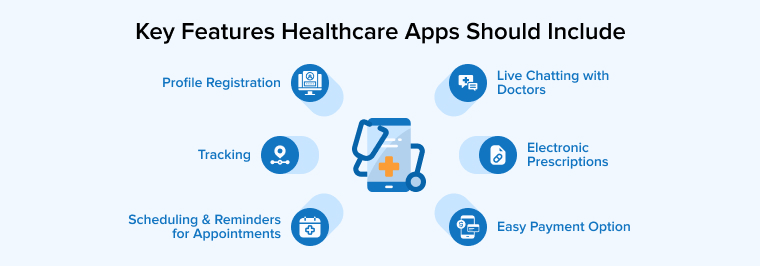
This section will discuss the essential features that a healthcare app should consist of:
1. Profile Registration
Patient data registration is a lengthy and involved process that includes various documentation and procedures. When a person has their initial consultation, they must provide detailed personal information, health records, sensitivities, drug history, and any prior substance misuse (if any).
Medical applications that include a registration feature simplify the process for both patients and healthcare providers. Individuals can use the healthcare apps to complete all required information before arriving at the hospital. Clinical staff get these facts relatively soon after patients complete them. This workflow minimizes patient wait times and enables health facilities to see more patients.
2. Tracking
The most critical feature of any patient app is its ability to supervise the patient‘s vital indications. These include blood pressure, respiratory rate, blood glucose levels, pulse, and calorie consumption.
3. Scheduling & Reminders For Appointments
The traditional method of contacting a clinic or hospital to inquire about open slots is outdated. One of the most desired aspects of healthcare software is the opportunity for users to schedule appointments at their convenience. This implies that a person may access a medical app at 2 a.m. and make a next-day booking.
This feature simplifies appointment scheduling and lowers workforce necessities at healthcare facilities. Patients may select whatever time slot they desire, regardless of their location, and it benefits both patients and physicians.
Missed visits are one of the leading causes of health decline in adults with heart disease and elders with geriatric disorders. Individuals may miss their appointments as a result of individual stress, professional obligations, or just because it slips their heads.
A hospital patient app that includes a function that reminds patients of upcoming visits assists patients in managing their health more effectively. Reminders can take the form of push alerts, timers, or programmed texts, and this is one feature that every user of a medical app wishes they had.
4. Live Chatting with Doctors
Patients may communicate with their specialists in real-time and receive immediate support through this feature. This functionality has the potential to improve accessibility to healthcare and foster confidence among doctors and patients.
5. Electronic Prescriptions
Providers can use electronic prescription software to create medications on their gadgets and transmit them immediately to a drugstore. This procedure is substantially more effective than the old way of providing patients with a handwritten prescription, which they must take to the pharmaceutical personnel.
Utilizing an e-prescription streamlines the procedure of dispensing and renewing medicines. It eliminates errors caused by readability issues with scribbled prescriptions, medication fraud, or patients accidentally losing their prescriptions.
6. Easy Payment Option
Mobile payment integration with cutting-edge online payment capabilities (wallets, credit/debit cards, and net banking) allows patients to pay for healthcare services and/or premiums securely and easily. Additionally, patients can obtain records of their invoices for future reference.
1.3 Benefits of Healthcare Apps
The following section lists the most significant advantages of healthcare mobile apps for both doctors and patients.
1. Benefits For Doctors
Here are some healthcare app benefits for doctors:
- Quick Decision Making: Medical officers can quickly access patients’ data through this type of application and proceed with the treatment within no time.
- More accurate diagnosing: Healthcare apps enable doctors to offer accurate treatment by going through patients’ files on the app.
- Better Communication: This type of platform offers better communication to doctors as they can connect and discuss crucial consultations.
- Reduced cost of healthcare provision: The cost of healthcare provision can be reduced with online services using this app.
- Less stress and burnout: Software helps doctors reduce their stress from mundane tasks and remove all paperwork.
- Remote assistance: With the help of mobile healthcare apps, doctors can monitor patients’ health through devices and save a lot of time by giving basic treatment via calls or chats.
2. Benefits For Patients
Here are some healthcare app benefits for patients:
- Higher quality care: The patients can get their healthcare plans and solutions on their mobile phones and they don’t have to physically meet the healthcare providers.
- On-demand accessible care: Healthcare software stores all the reports and past records of the patient which is beneficial for on-demand access.
- Better control over health data: Patients can control their healthcare issues via phone by connecting to the doctors easily and storing the medical records in one place.
- Secure payments: Medical solution provider apps come with in-app payment methods that are secure for the patients to make payments for their treatments.
- Engagement: This type of solution enables the patients to actively participate in their healthcare process.
2. Step by Step Healthcare Application Development Process
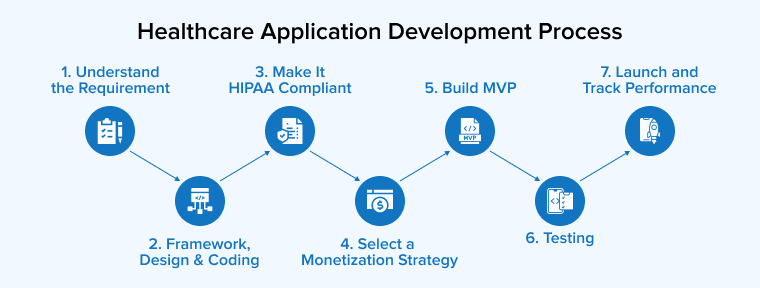
The healthcare mobile application development process can be complex and challenging due to evolving trends and user needs. Here is a step-by-step explanation of how to build a successful healthcare app.
2.1 Brainstorm and Understand the App Requirement
There are several mobile healthcare applications available on the Internet. How would yours add worth to target users and make them think you’re different from others? You must undertake extensive marketplace and competitor analysis to uncover shortfalls that your solution might effectively answer.
Consultations with doctors, caregivers, clinical key personnel, patients, and other decision-makers can shed light on ways to develop a truly beneficial, realistic outcome.
With the help of research, you may establish your intended group’s particular potential pitfalls and needs. This understanding will be used to create an effective bespoke medical solution.
As obvious as it sounds, if your healthcare app is not beneficial, it will be a pointless exercise. Market research is required while developing healthcare apps. You must research your area, and have a better understanding of your competition, the value they provide, their negative and positive points, and how you may differentiate yourself.
The user research step is necessary in such a scenario. While healthcare mobile application development, you should always be prepared to deal with people’s sensitive issues. A structured questionnaire, group discussions, or polls is difficult because you must strike a balance between getting to the base of the customer’s issue and maintaining a moral approach.
2.2 Framework, Design & Coding
It is critical to strike a balance between uniqueness and established trends while beginning the development of healthcare apps. A user-friendly design that requires a few steps toward job completion is a delicate balancing act that the healthcare software product development team must master. The secret to creating a great mHealth app is having a design that is both responsive and friendly.
At this step, the designs are officially coded. Appropriately dividing up the work, the developers create a reasonable timeline. Everything starts rolling once the technological stack is settled upon.
2.3 Make It HIPAA Compliant
There are specific rules that must be followed if you want to release a healthcare app.
The United States market will demand that your software must adhere to all HIPAA rules. All apps in Europe that handle personal data must follow the General Data Protection Regulation.
The goal of HIPAA is to provide both patients and doctors peace of mind by safeguarding their private medical records.
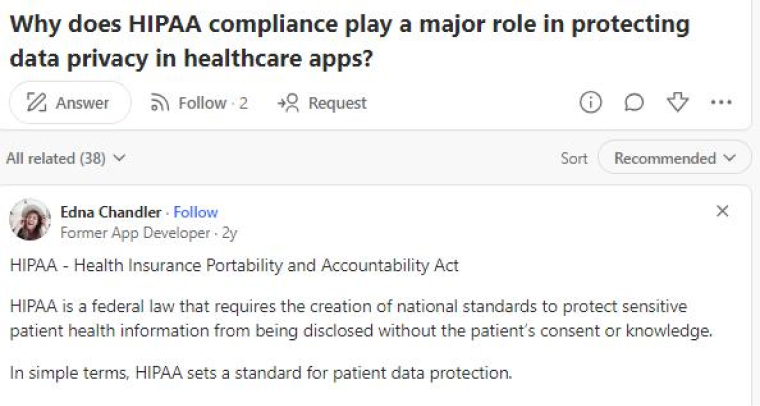
2.4 Select a Monetization Strategy
The application you develop must be financially sustainable. Ultimately, one of the principal motives behind any digital product development is to generate profit along with revenue. Hence, the selection of the relevant monetization strategy forms an essential part of the mobile app development process. Generally, it’s preferred to select the monetization model before the actual app development begins. However, after the product is ready, you can more easily decide on a suitable app monetization model.
Now, there are some standard monetization models suitable for healthcare domain mobile applications:
- Subscription: Users will have to pay some charges to access the services at regular time intervals, for example, a one-year subscription. This model keeps the user engaged in your application along with stable incoming revenue.
- Pay-per-Download: Users need to pay a one-time fee to download the app. Some users may prefer free apps, but a good-quality app will attract users, and they will pay the downloading fee voluntarily.
- In-App Advertisements: The application can include related advertisements, such as ads from medical device manufacturers and drug sellers. The respective partners will pay for the ads in return.
- Freemium: The application is free to use, but some of its features require in-app purchases.
- Licensing: You are allowing other organizations or brands to use your application or the technology involved in building the app for free of cost.
You can go for any of these models after assessing your business requirements.
2.5 Build MVP
While developing the MVP for a healthcare app, it is critical to adhere to the core MVP construction rules: create it quickly and make it feasible.
Before developing the MVP for healthcare apps, it is essential to pick the most critical features, confirm they answer the issue and test regularly. An MVP provides you with a competitive edge since it allows you to reach the marketplace quicker and collect input from real consumers than if you immediately construct a compact solution.
2.6 Testing
Testing a medical app must adhere to several standards. It is a component of the software’s post-development phase. During testing, evaluate performance, response speed, usability, and designs. If the specifications are determined to be fulfilled, then the healthcare mobile app is prepared for release.
However, any issues discovered are reported, and corrected, and the screening process is restarted.
2.7 Launch and Track Performance
When your app has been thoroughly vetted, you may finally open it to the public. After releasing your app, it’s important to monitor its success with the help of the analytics tools you built into it during development. Additionally, respond to user feedback, and provide regular updates.
Even though this was the standard procedure for creating a healthcare app, your app can differentiate itself from the competition by its unique idea and set of features.
3. HIPAA Rules for Healthcare App Development
The Health Insurance Portability and Accountability Act (HIPAA) is a US federal rule that all healthcare organizations that manage patient records must follow. It is broad legislation that every health technology must follow to avoid serious legal repercussions. This section concerns HIPAA compliance.
HIPAA provides a baseline for safeguarding critical patient medical records and is applicable to all companies that collect health documentation. Businesses that disobey this legislation suffer harsh legal repercussions and hefty fines. According to the seriousness of the cyberattack caused by non-compliance, individuals may also risk prosecution.
HIPAA, the Health and Portability Accountability Act of 1996, is a healthcare privacy law and thus only applies to entities within the healthcare field, such as medical professionals. It does not prohibit asking questions about someone's health.https://t.co/IeMUsH5tSf pic.twitter.com/6CgMvKWhQA
— Business Insider (@BusinessInsider) August 5, 2021
Healthcare app development procedures must adhere to HIPAA regulation policy to fit the criteria. According to the privacy regulation, the legislation mandates adequate safeguards to protect individuals’ health data. Additionally, the use and dissemination of such details are restricted without previous agreement from patients.
Additionally, the privacy and security regulations provide patients with access to their health information. The patient can seek a copy of their records and, if necessary, to have them corrected. The rule primarily affects health insurers and intermediaries.
The HIPAA security regulation establishes national requirements for safeguarding individuals’ electronic health records when they are accessed or modified by a healthcare provider. Various electronic, organizational, and regulatory protections for critical health data are included in the guidelines.
In consideration of both cybersecurity and confidentiality restrictions, developers of mobile medical apps must guarantee that their products adhere to the standards. It is vital to secure patients’ medical well-being and prevent legal ramifications. The programmers are responsible for ensuring that all technological precautions are appropriate.
4. How Much Does It Cost To Develop A Healthcare App?
Creating software is a complex procedure that encompasses its lifetime. As with any sort of app development, there are expenses associated with developing a healthcare application. This part will describe the aspects that contribute to the development expense.
Each program has its specific set of different issues that are specific to the sector it addresses. The pre-production, production, and post-production phases comprise the approach for producing a mobile healthcare application. Every phase has its own set of budgets, which add together to provide a reasonably accurate estimation. Several of the variables influence the price of healthcare app development.
4.1 Application Design
The cost of developing complete healthcare apps is significantly affected by their functionality. The less functionality an app has, the simplified its design and the less expensive it is. On the other hand, software with a large number of features is almost certain to have a highly complicated design, which increases expenses.
4.2 Features
As previously said, software with complex features, such as artificial intelligence algorithms, machine learning, computing, and so on would always charge beyond software with basic functions.
Capturing bio-vitals, assessing them over time, and sharing this information with clinicians requires a team with the necessary skill sets. Additionally, the computer data volume required to store and analyze such data for a large number of users will eventually raise the entire development budget. On the contrary, a basic app, such as one that tracks the number of kilometers run or calories consumed, may operate on a shoestring cost.
4.3 Platform
The architecture on which the software will be created heavily influences the budget. Costs associated with producing for the Android OS are greater than those associated with creating for the iOS. However, the positive is that Android has a larger customer base, which means it may have a greater competitive reach.
However, the majority nowadays want to develop an app for both operating systems, which necessitates the creation of separate groups to develop the corresponding front ends for the two prominent systems. Having multiple teams work on software for Android, and iOS greatly increases the expenses.
| App Features | Apx. Hourly Development Time | Apx. Estimation (USD) |
|---|---|---|
| A sign-up and log-in procedure | 70-76 | 2,000- 2,600 |
| Control Center | 250-280 | 9,000-10,000 |
| Telephone and videoconferencing | 300-350 | 4,000-5,000 |
| E-Prescription | 200-240 | 6,000-7,500 |
| Patients Demographics | 320-380 | 10,000-12,000 |
| Two profiles (the doctor and the patient) are displayed on the screen | 120-160 | 2,000-2,800 |
| Powerful indexing and sorting tools | 100-120 | 2,000-2,800 |
| Live chat | 300-320 | 9,000-11,000 |
| Backend architecture & Web Admin | 1800-2000 | 35,000-40,000 |
| Setting up an appointment | 320-360 | 5,000-6,500 |
| Appointment History and Follow up sessions | 140-180 | 5,000-6,500 |
| Hipaa Compliance | 700-800 | 23,000-27,000 |
| Integration with EHR | 280-320 | 10,000-11,000 |
| Verbal interaction over the Internet | 110-120 | 4,000-5,000 |
| Documentation of source code | 40-50 | 500-800 |
| Payment choices | 80-100 | 1,000-1,500 |
| Billing and Invoicing | 200-240 | 6,500-8,000 |
| Notifications | 160-200 | 5,000-6,500 |
| Reports & Analytics | 180-200 | 6,000-7,000 |
| Subscription | 160-180 | 5,500-6,000 |
5. Healthcare App Development Trends
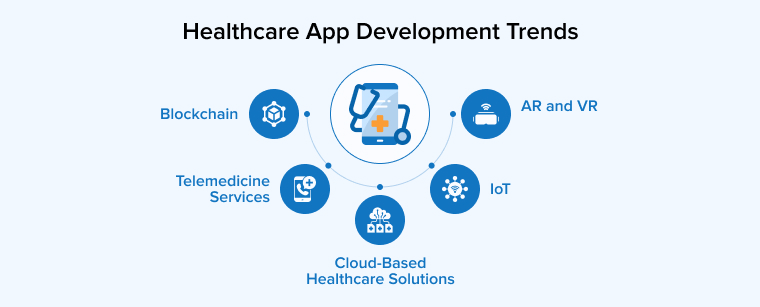
Following are the healthcare app development trends:
5.1 Telemedicine Services
Experts in the medical field estimate that 75% of all hospital visits are for routine matters that may be handled over the phone or by video conferencing. Telemedicine offers a solution. The feature allows people to communicate with their physicians from the convenience of their own homes.
Since bridging the boundary between patients and doctors, telemedicine and telehealth have already had a profound effect on the healthcare system. Yet, telehealth’s popularity is only expected to grow, making it an integral aspect of healthcare’s growing trends in 2022 and a significant factor in at-home medical treatment.
5.2 Blockchain
Blockchain is a cutting-edge innovation that will revolutionize the healthcare industry. The interoperability problem is one of the most pressing problems in the industry, and blockchain technology offers a promising solution. Solutions like Medblock, for instance, Medblock let Healthcare companies canto communicate patient data securely on a permissioned ledger, guaranteeing the immutability of all patient information using blockchain.
Other benefits are:
- Integration across several EHR platforms.
- Tracing pharmaceuticals across the supply chain.
- Free and independent patient portals where each individual has complete authority over her medical records.
5.3 Cloud-Based Healthcare Solutions
Cloud-based healthcare apps offer several advantages, including Advantages, such as health data analytics, which are an additional perk of cloud-based healthcare apps, in addition to the convenience of giving patients the freedom to access their records whenever they need them.
Including cloud computing technologies in your healthcare mobile app development can improve communication and data management.
5.4 Augmented Reality and Virtual Reality (AR/VR)
Despite augmented reality (AR)and /or common virtual reality(VR) technologies being often dismissed as gimmicky tech best suited for games like Pokemon, it has many serious medical uses. The use of a virtual environment in treatment, especially when it’s done remotely, is the first thing that springs to mind. Using augmented reality (AR) for interior navigation in clinics is another useful application of AR for surgical training and education.
5.5 IoT
It’s been a growing movement for some time now to connect medical devices and equipment to the Internet. New technological developments, however, are revealing many more scenarios that might benefit from this innovative approach. The capabilities of today’s healthcare IoT systems extend far beyond the simple monitoring of vital signs. In addition to improving remote patient monitoring, IoT has also been shown to aid in the administration of medical supplies, surgical support, and pharmaceuticals.
It works on other objectives like,
- Medical equipment that is both smart and effective.
- Devices that can monitor your heart and brain activity, such as the ECG and EDA, that you wear.
- Meds that can be tracked down in case of an emergency.
6. How We Can Assist You with Development or Tatvasoft Experience
Tatvasoft is a leading healthcare app development company specializing in creating custom healthcare applications that can help streamline medical operations, manage patients’ data, enhance patient care, and more. We redefine the healthcare industry by offering services from clinical management to efficient patient diagnosis.
We at TatvaSoft have vast experience in healthcare app development and more and hence understand personally how to take your HIPAA-compliant solution from concept to ready-to-launch product.
Whether you’re seeking a healthcare app development company or want expert advice for your business, you’ve come to the right place. Reach out—it’d be our pleasure.
7. Conclusion
The health domain is a crucial sector as it involves the lives of the people. Today, with changing times, there has come a change in people’s lifestyles, ranging from their eating and working habits to sleeping patterns. Therefore, the existing technologies must evolve accordingly to give the best solutions. Healthcare applications are a digital transformation in the healthcare industry. After COVID, the speed of this transition has accelerated by multiple times. We saw above the benefits of these advancing healthcare mobile applications. These benefits are a leading factor for the vast investment in healthcare application development services by the healthcare industry.
The above blog covers the healthcare application development process in complete detail. You need to pay proper attention to many significant factors from multiple perspectives before moving toward full fledged development. We’ve tried to explain the required technicalities in a simple manner so that it’s easy for you to understand. We’ll come with more blogs in this healthcare domain. Till then keep reading.
FAQ
How Do I Create a Health Care App?
To create a healthcare application for your organization, you look for the best healthcare app development company in the market and approach the one you prefer. The rest you can leave on the development team.
How Much Does It Cost to Build a Healthcare App?
When it comes to creating a healthcare application for Android and iOS, the cost can approximately be $100k to $150k. But this amount differs from firm to firm as per their requirements.
How Long Does It Take to Develop a Healthcare App?
To create a healthcare app, companies can take 6-18 months depending on the size of the application and the requirements of the healthcare provider.


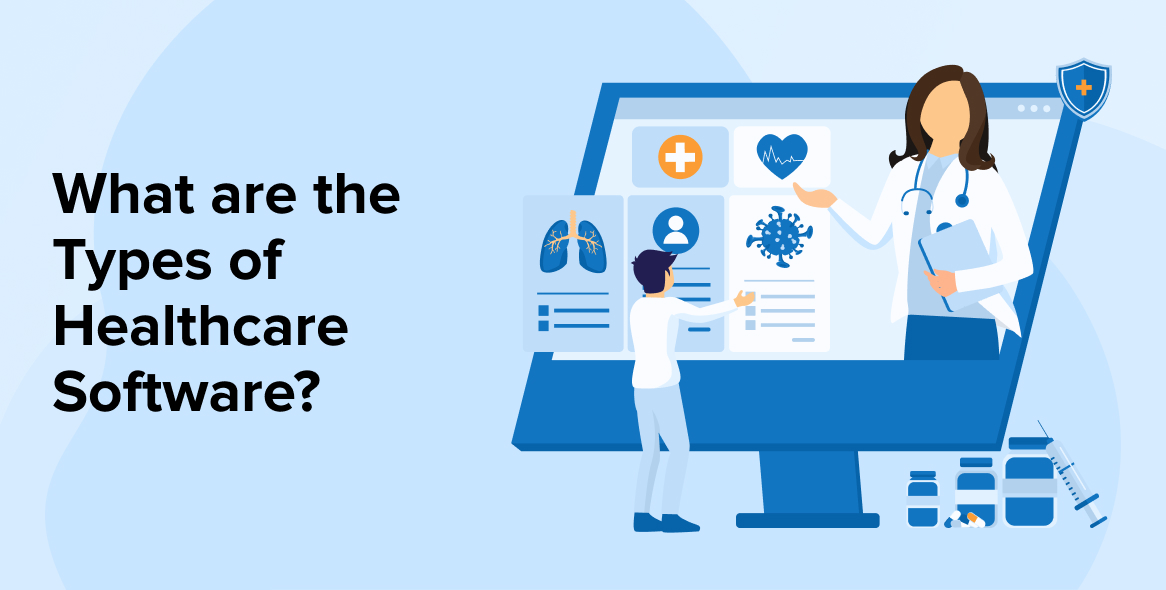
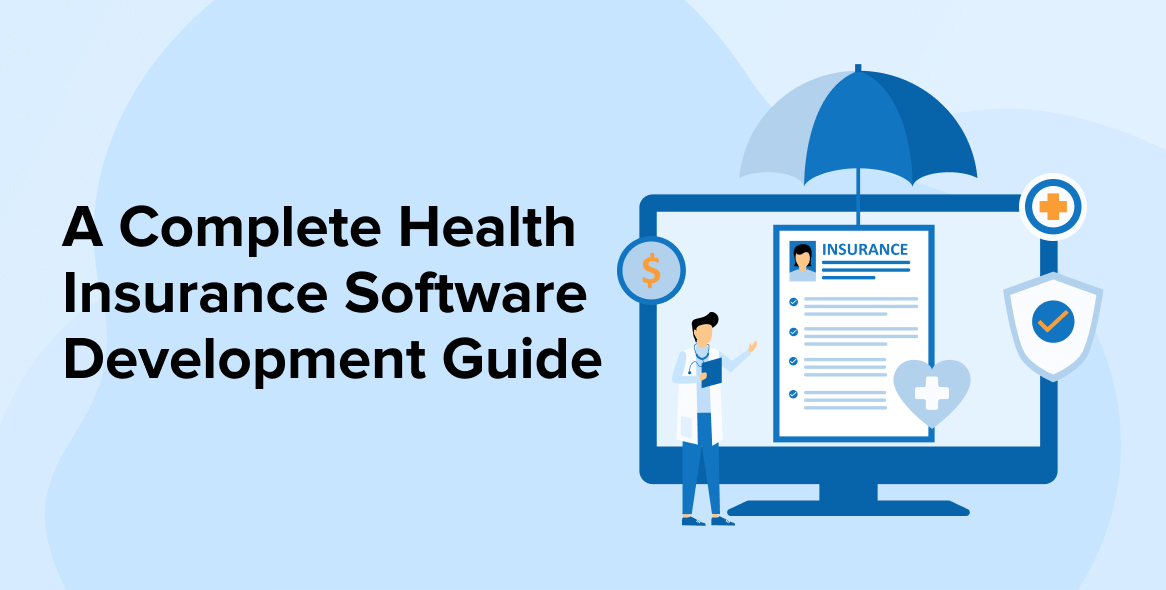
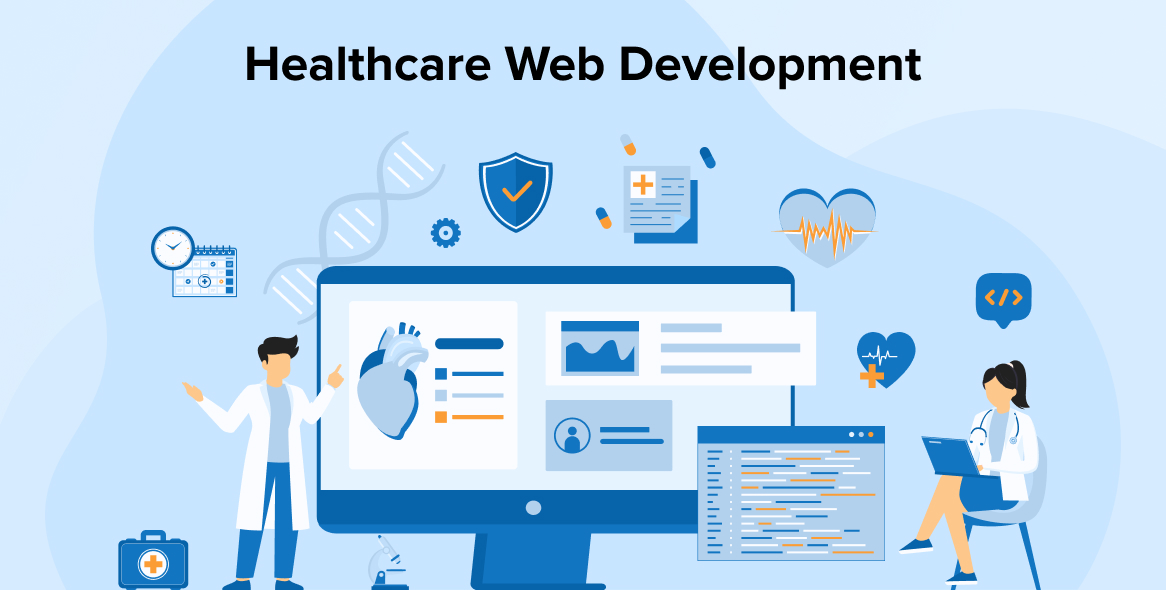

This article comprehensively describes healthcare applications, including their features, types of development, development steps, and cost. I highly recommend this article to anyone interested in learning more about healthcare application development.
The author thoroughly explores Healthcare Application Development in this article, covering a range of features such as Profile Registration, Appointment Scheduling & Reminders, Convenient Payment Options, Live Chat with Doctors, and much more.
This article is exactly what I've been looking for! I'm planning to develop a health app for my business and this detailed guide on healthcare application development is super helpful, clearing up some of my doubts. Thanks for sharing such a valuable resource.